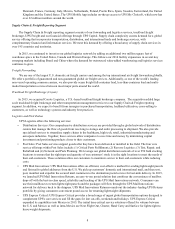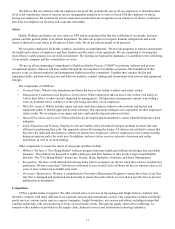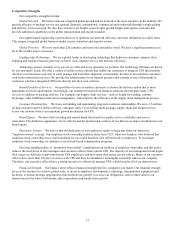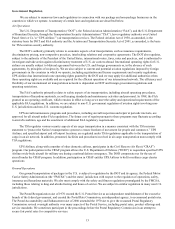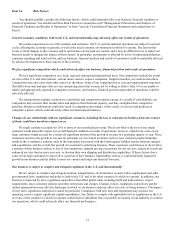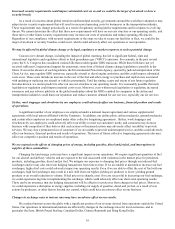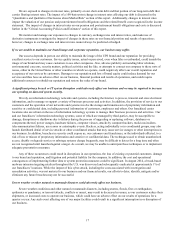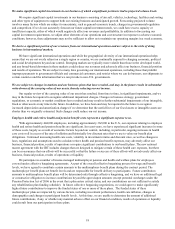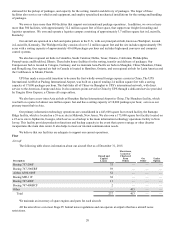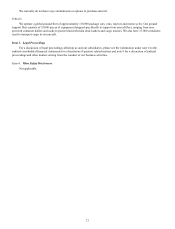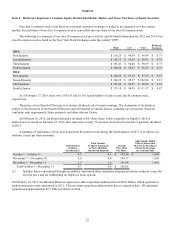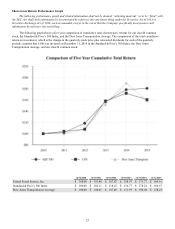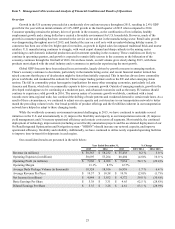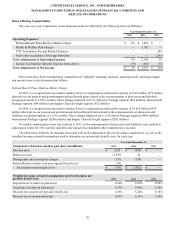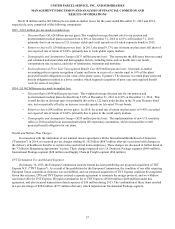UPS 2015 Annual Report Download - page 30
Download and view the complete annual report
Please find page 30 of the 2015 UPS annual report below. You can navigate through the pages in the report by either clicking on the pages listed below, or by using the keyword search tool below to find specific information within the annual report.18
We make significant capital investments in our business of which a significant portion is tied to projected volume levels.
We require significant capital investments in our business consisting of aircraft, vehicles, technology, facilities and sorting
and other types of equipment to support both our existing business and anticipated growth. Forecasting projected volume
involves many factors which are subject to uncertainty, such as general economic trends, changes in governmental regulation
and competition. If we do not accurately forecast our future capital investment needs, we could have excess capacity or
insufficient capacity, either of which would negatively affect our revenues and profitability. In addition to forecasting our
capital investment requirements, we adjust other elements of our operations and cost structure in response to adverse economic
conditions; however, these adjustments may not be sufficient to allow us to maintain our operating margins in a weak economy.
We derive a significant portion of our revenues from our international operations and are subject to the risks of doing
business in international markets.
We have significant international operations and while the geographical diversity of our international operations helps
ensure that we are not overly reliant on a single region or country, we are continually exposed to changing economic, political
and social developments beyond our control. Emerging markets are typically more volatile than those in the developed world,
and any broad-based downturn in these markets could reduce our revenues and adversely affect our business, financial position
and results of operations. We are subject to many laws governing our international operations, including those that prohibit
improper payments to government officials and commercial customers, and restrict where we can do business, our shipments to
certain countries and the information that we can provide to non-U.S. governments.
We are subject to changes in markets and our business plans that have resulted, and may in the future result, in substantial
write-downs of the carrying value of our assets, thereby reducing our net income.
Our regular review of the carrying value of our assets has resulted, from time to time, in significant impairments, and we
may in the future be required to recognize additional impairment charges. Changes in business strategy, government
regulations, or economic or market conditions have resulted and may result in further substantial impairments of our intangible,
fixed or other assets at any time in the future. In addition, we have been and may be required in the future to recognize
increased depreciation and amortization charges if we determine that the useful lives of our fixed assets or intangible assets are
shorter than we originally estimated. Such changes could reduce our net income.
Employee health and retiree health and pension benefit costs represent a significant expense to us.
With approximately 444,000 employees, including approximately 362,000 in the U.S., our expenses relating to employee
health and retiree health and pension benefits are significant. In recent years, we have experienced significant increases in some
of these costs, largely as a result of economic factors beyond our control, including, in particular, ongoing increases in health
care costs well in excess of the rate of inflation and historically low discount rates that we use to value our benefit plan
obligations. Continued increasing health care costs, volatility in investment returns and discount rates, as well as changes in
laws, regulations and assumptions used to calculate retiree health and pension benefit expenses, may adversely affect our
business, financial position, results of operations or require significant contributions to our benefit plans. The new national
master agreement with the IBT includes changes that are designed to mitigate certain of these health care expenses, but there
can be no assurance that our efforts will be successful or that the failure or success of these efforts will not adversely affect our
business, financial position, results of operations or liquidity.
We participate in a number of trustee-managed multiemployer pension and health and welfare plans for employees
covered under collective bargaining agreements. As part of the overall collective bargaining process for wage and benefit
levels, we have agreed to contribute certain amounts to the multiemployer benefit plans during the contract period. The
multiemployer benefit plans set benefit levels and are responsible for benefit delivery to participants. Future contribution
amounts to multiemployer benefit plans will be determined only through collective bargaining, and we have no additional legal
or constructive obligation to increase contributions beyond the agreed-upon amounts (except potential surcharges under the
Pension Protection Act of 2006 in the event that a plan enters critical status, and our contributions are not sufficient to satisfy
any rehabilitation plan funding schedule). In future collective bargaining negotiations, we could agree to make significantly
higher future contributions to improve the funded status of one or more of these plans. The funded status of these
multiemployer plans are impacted by various factors, including investment performance, health care inflation, changes in
demographics and changes in participant benefit levels. At this time, we are unable to determine the amount of additional
future contributions, if any, or whether any material adverse effect on our financial condition, results of operations or liquidity
could result from our participation in these plans.


